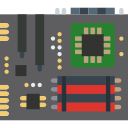How To Undervolt Your GPU To Gain Performance In Games
The gaming industry has drastically changed since the last couple of years. Every year, new games are announced that are stunning both visually, and aesthetically but require high GPU and CPU power. With that said, gaming enthusiasts are left with two options, either upgrade their current hardware or opt for overclocking.
However, overclocking or even new GPUs – if pushed to max – can lead to high temperatures. This can cause several problems, including hardware lifespan reduction, performance instabilities, loud noise because of fan throttling at max speed, and thermal throttling.
You must be wondering, what should I do, right? The answer is simple, “undervolting”.
With undervolting, you gain tons of benefits, but the main question arises; how to undervolt your GPU to gain performance in games? If you are one of the curious gaming enthusiasts, then you are in the right place. So, without further ado, let’s get started!
What is Undervolting?
For all the beginners out there, undervolting is a simple process of reducing the voltage consumption of your GPU. High voltage/power leads to an increased temperature, which can further downgrade performance when thermal throttled, and in some cases, it can even damage your graphics card.
While undervolting is an amazing way to get the most juice out of your card, abusing it can cause serious damage to your hardware. But hey, don’t worry, that’s why we are here.
How to Undervolt your GPU?
Now that we have covered our basics let us dive right into how you can undervolt your GPU.
Prerequisites:
- MSI Afterburner (My personal favorite overclocking utility) that you can download from here: https://www.msi.com/page/afterburner
- GPU-Z (A utility dedicated to monitoring GPU temperatures and consumption, but this is optional since MSI Afterburner provides similar features). You can download it from here: https://www.techpowerup.com/download/gpu-z/
Once you have downloaded the necessary software, follow the steps to ensure that you don’t overvolt your GPU.
Step 1: Initialization
This step is the most basic of all. All you have to do is open MSI Afterburner and hit on settings.
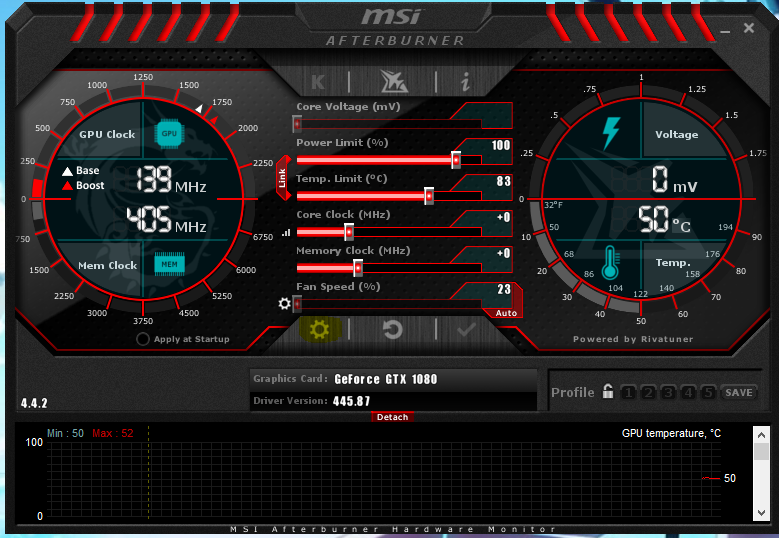
Once you’re in settings, a small window will pop up. Scroll down a bit until you see “Unlock voltage monitoring”, and select that option.
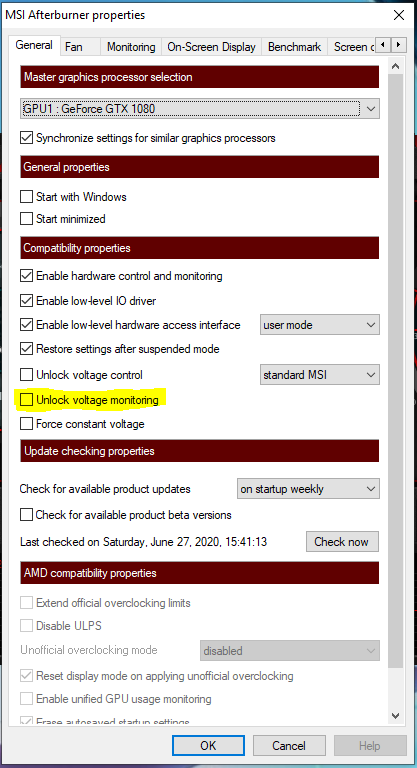
After that, all you have to do is to click on “OK”. Once you’ve done that, a voltage value indicator will be visible, as soon as the software has rebooted itself.
So far, so good, right?
Step 2: Playing with the Voltage/Frequency Curve

The real undervolting process begins from here. In MSI Afterburner, you can either click the button or press CTRL + F key to open the curve editor as shown below.
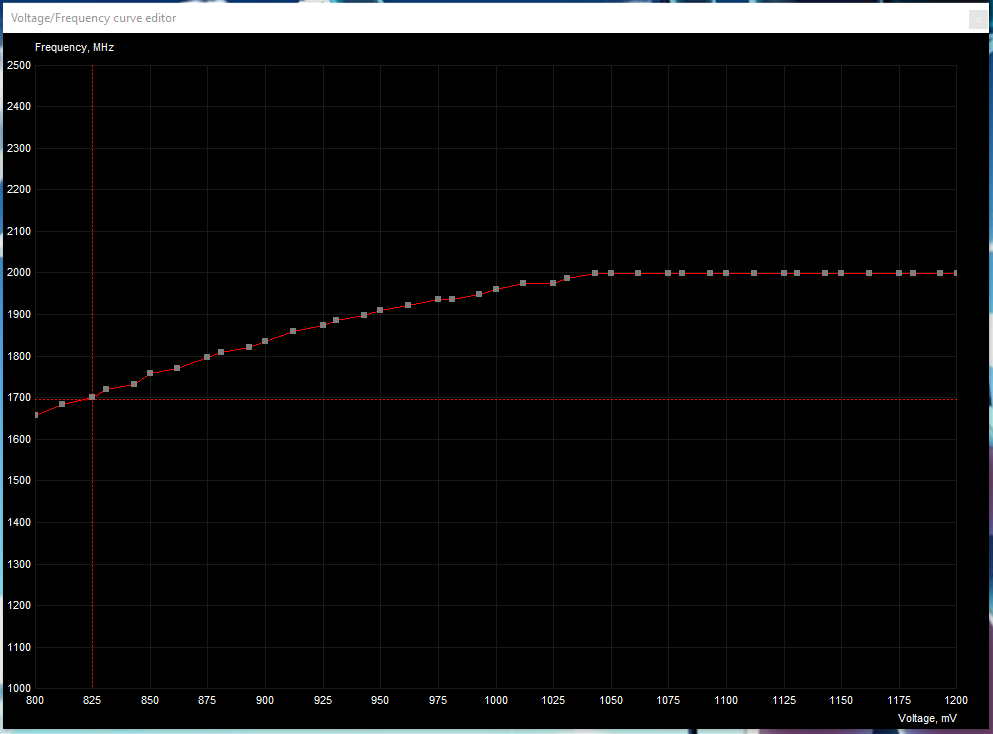
Here, the x-axis shows the voltage in millivolts (mV), and the y-axis display frequency in megahertz (MHz). The dotted red line, on the other hand, displays the current-voltage and the frequency value of your GPU.
For example, at 825 mV, my GTX 1080 will operate at 1664 Mhz. If you increase the voltage, your GPU will consume more power, thereby leading to increased temperatures and potential thermal throttling.
If you look closer, you can see silver, square-shaped boxes. To change the voltage value and frequency, click on one of the silver boxes with your mouse and drag it up or down to adjust the setting. You can lower the voltage by selecting the square-shaped boxes, and lower the frequency at that voltage by dragging that box upwards or downwards.
Remember, it is not recommended to increase the frequency of the GPU too high or lower the voltage below 200 mV. These settings can potentially damage your card or crash your applications.
For the stability and safety of my graphics card, I will keep my voltage at 812 mV.
Step 3: Fine-Tuning
After understanding how the Voltage/Frequency curve works, its time for you to fine-tune your voltage value point-by-point.
As an example, my GTX 1080 runs 1664MHz@825mV. If we go to a step-down, my GPU will run 1657MHz@812mV. Alternatively, you can change the frequency level of 1657Mhz@812mV to 1667MHz@812mV, or you can lower the frequency from 1657Mhz@812mV to 1645Mhz@812mV. This way, your GPU will not waste any power on nearly no frequency improvement.
After you have selected your desired voltage and frequency, close the curve and move on to step four, to test the stability of the GPU. If everything is set, you can further move to the next voltage point, which, on my GTX 1080, is 800mV.
If you encounter any problem, go back to the curve, and lower the frequency. For instance, if you encounter a problem with 1657MHz@812mV, you can lower the frequency by 10Mhz 1647Mhz@812mV. This way, you can check which voltage and frequency setting work the best for your GPU.
Step 4: Checking Stability
After you have selected the lower voltage and adjusted the frequency at that voltage, close your “Voltage/Frequency curve editor” and hit on the checkmark present on the MSI Afterburner.

Now, run any benchmark and check the stability of your GPU.
Ideally, you are required to run the benchmark for more than 5 minutes in order to assess the stability fully. If your game crashes, revert back to step 3.
Step 5: Restore Settings (optional)
This step is optional. If you wish to go back to your default GPU voltage settings, you can click on this button to reset everything.
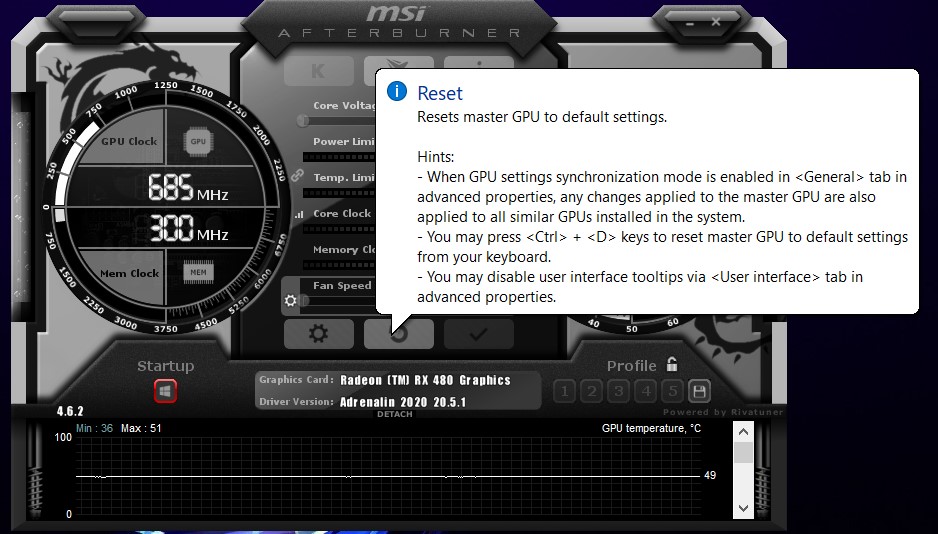
Final Verdict
Now that you know how to undervolt your GPU, you can get maximum performance at lower voltage levels. Albeit higher frequency means better overall performance, the trade-off isn’t really worth it if it causes your GPU to overheat.
The sweet spot is where you can get maximum frequency at a lower voltage. This way, your GPU will run adequately faster while consuming lower voltage.
So, what are you waiting for? Undervolt your GPUs to your heart’s content and play games or if your GPU is not performing up to your expectations even after undervolting, then consider getting a brand new GPU such as these RX 5700XT GPUs from AMD.



